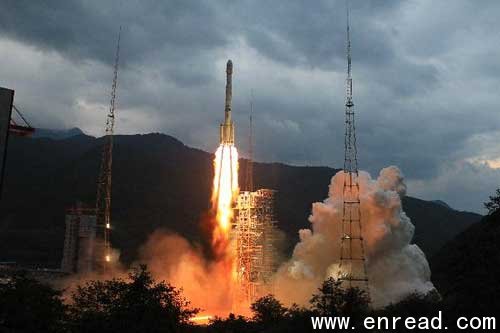| ||||||||||||||||||||||||||||||||||||||||||||||||||||||||||||||||
|
西昌卫星发射中心10月1日宣布,“嫦娥二号”卫星准确入轨,发射圆满成功。  Long March 3C rocket carrying China's second unmanned lunar probe, Chang'e-2, lifts off from the launch pad at the Xichang Satellite Launch Center in southwest China's Sichuan Province, at 18:59:57 China launched its second unmanned lunar probe, Chang'e-2 on Friday, inaugurating(创新,开辟) the second phase of a three-step moon mission, which will culminate1 in a soft-landing on the moon. At 6:59:57 pm, the satellite blasted off(点火起飞) on a Long March 3C carrier rocket from No 2 launch tower at the Xichang Satellite Launch Center in southwest China's Sichuan Province. "Chang'e-2 lays foundation for the soft-landing on the moon and further exploration of outer space," said Wu Weiren, chief designer of China's lunar orbiter project. Chang'e-2 entered the orbit with a perigee2(近地点) of 200 kilometers and apogee3(最高点,极点) of 380,000 kilometers as scheduled. There it separated from the carrier rocket(运载火箭) . It was the first time that a Chinese lunar probe directly entered the earth-moon transfer orbit without orbiting the earth first. "It is a major breakthrough of the rocket design, as it saves energy used by the satellite and speeds up the journey to the lunar orbit," said Pang4 Zhihao, a researcher with the China Academy of Space Technology. The lunar satellite is expected to take about 112 hours, or almost five days, to arrive at its lunar orbit, faster than the 12 days taken by the Chang'e-1 three years ago. "It travels faster and closer to the moon, and it will capture clear pictures," Wu said. Chang'e-2, named after a legendary5(传说的) Chinese goddess of moon, will orbit 100 kilometers above the moon, compared with 200 kilometers for Chang'e-1. Total expenditure6(支出,经费) for the Chang'e-2 mission is about 900 million yuan ($134.33 million). China launched its first lunar probe, Chang'e-1, in October 2007, marking a milestone7 in the country's space exploration. After orbiting for 494 days and intentionally8 crashing onto the lunar surface, Chang'e-1 sent back 1.37 terabytes of data, producing China's first complete moon picture. The data has been shared with other countries for free. China became the third country after Russia and the United States to send a person into space in 2003. Two more manned space missions followed with the most recent in 2008 involving China's first human space walk. 点击  收听单词发音 收听单词发音
|
||||||||||||||||||||||||||||||||||||||||||||||||||||||||||||||||
上一篇:朝鲜领导人之子被任命重要党内职位 下一篇:印尼爆发洪水泥石流 26人死亡 |
||||||||||||||||||||||||||||||||||||||||||||||||||||||||||||||||
- 发表评论
-
- 最新评论 进入详细评论页>>



